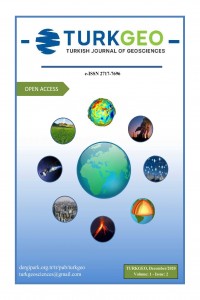Abstract
References
- Ateş, H.B. (2011). TUSAGA-Aktif GPS ağ verileri ile bölgesel iyonosferik modelin oluşturulması (MSc thesis). Gebze Institute of Technology, Kocaeli, Turkey.
- Erdönmez, O. (2008). Troposferik gecikmelerin GPS ölçülerine olan etkisinin araştırılması (MSc thesis). Yildiz Technical University, Istanbul, Turkey.
- Erkan, Y. (2008). Troposferik gecikme modellerinin GPS nokta konumlarına etkisi (MSc thesis). Zonguldak Karaelmas University, Kocaeli, Turkey.
- Glowacki, T.J., Penna, N.T., Bourke, W.P. (2006). Validation of GPS-based estimates of integrated water vapour for the Australian region and identification of diurnal variability. Australian Meteorological Magazine, 55(2), 131–148.
- Hopfield, H. (1971). Tropospheric effect on electromagnetically measured range: prediction from surface weather data. Radio Science, 6(3), 357–367. Kahveci, M. (1997). Investigation of the effects of propagation errors on GPS observations in Turkey region (PhD thesis). Istanbul Technical University, Istanbul, Turkey.
- Kınık, İ. (1999). GPS ölçme ve değerlendirmelerinde hata kaynakları üzerine bir inceleme (PhD thesis). Yildiz Technical University, Istanbul, Turkey.
- Koca, B., Ceylan, A. (2018). Uydu konum belirleme sistemlerindeki (GNSS) güncel durum ve son gelişmeler. Journal of Geomatics, 3(1), 63-73.
- Özuğur, İ. (2019). Ticari GPS yazılımlarında kullanılan troposfer modellerinin karşılaştırılması (MSc thesis). Aksaray University, Aksaray, Turkey.
- Smith, E.K., Weintraub, S. (1953). The constants in the equation for atmospheric refractive index at radio frequencies. Proceedings of the IRE, 41(8), 1035-1037.
- Yılmaz, S. (2013). GNSS verilerinden hesaplanan elipsoid yüksekliklerinin atmosferik verilerle iyileştirilmesi (PhD thesis). Selcuk University, Konya, Turkey.
Abstract
The Global Navigation Satellite System (GNSS) is one of the most important inventions in the history of the survey. GPS in 1974 and GLONASS in 1976 were established and used for military purposes, and they were opened to civil use since 1980 and 1982 respectively and started to be used in daily life. The GNSS system has developed very rapidly in line with technological studies and these rapid developments have directed scientists to develop new methods that can meet the needs of users and get the most accurate results. One of the best studies to minimize the effect on GNSS signals in the atmosphere is the use of dual-frequency GNSS receivers. These receivers can eliminate errors on GNSS signals in the ionosphere layer. However, they cannot eliminate the errors occurring in the troposphere layer. To eliminate these errors, the tropospheric effect can be minimized by measuring the humidity, temperature and pressure values at each point of the survey and using these values in calculations. But since this process will take a lot of time and is very costly, tropospheric models have been made by scientists. By using these models in GNSS software, the effect of the troposphere layer on the signals can be minimized. In this study, four different survey campaigns were conducted to observe the effect of Troposphere models under different atmospheric conditions. Topcon Tools ver.7 and Leica Geo Office 7.0 software were used to evaluate these campaigns. The effects of troposphere models on these calculations have been observed. The atmospheric values measured at the time of the session and the atmospheric values are taken from the General Directorate of Meteorology were included in the calculations and the results were compared.
References
- Ateş, H.B. (2011). TUSAGA-Aktif GPS ağ verileri ile bölgesel iyonosferik modelin oluşturulması (MSc thesis). Gebze Institute of Technology, Kocaeli, Turkey.
- Erdönmez, O. (2008). Troposferik gecikmelerin GPS ölçülerine olan etkisinin araştırılması (MSc thesis). Yildiz Technical University, Istanbul, Turkey.
- Erkan, Y. (2008). Troposferik gecikme modellerinin GPS nokta konumlarına etkisi (MSc thesis). Zonguldak Karaelmas University, Kocaeli, Turkey.
- Glowacki, T.J., Penna, N.T., Bourke, W.P. (2006). Validation of GPS-based estimates of integrated water vapour for the Australian region and identification of diurnal variability. Australian Meteorological Magazine, 55(2), 131–148.
- Hopfield, H. (1971). Tropospheric effect on electromagnetically measured range: prediction from surface weather data. Radio Science, 6(3), 357–367. Kahveci, M. (1997). Investigation of the effects of propagation errors on GPS observations in Turkey region (PhD thesis). Istanbul Technical University, Istanbul, Turkey.
- Kınık, İ. (1999). GPS ölçme ve değerlendirmelerinde hata kaynakları üzerine bir inceleme (PhD thesis). Yildiz Technical University, Istanbul, Turkey.
- Koca, B., Ceylan, A. (2018). Uydu konum belirleme sistemlerindeki (GNSS) güncel durum ve son gelişmeler. Journal of Geomatics, 3(1), 63-73.
- Özuğur, İ. (2019). Ticari GPS yazılımlarında kullanılan troposfer modellerinin karşılaştırılması (MSc thesis). Aksaray University, Aksaray, Turkey.
- Smith, E.K., Weintraub, S. (1953). The constants in the equation for atmospheric refractive index at radio frequencies. Proceedings of the IRE, 41(8), 1035-1037.
- Yılmaz, S. (2013). GNSS verilerinden hesaplanan elipsoid yüksekliklerinin atmosferik verilerle iyileştirilmesi (PhD thesis). Selcuk University, Konya, Turkey.
Details
| Primary Language | English |
|---|---|
| Subjects | Geological Sciences and Engineering (Other) |
| Journal Section | Research Articles |
| Authors | |
| Publication Date | December 15, 2020 |
| Submission Date | July 28, 2020 |
| Acceptance Date | August 24, 2020 |
| Published in Issue | Year 2020 Volume: 1 Issue: 2 |


